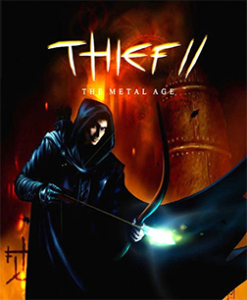987th played so far
Genre: Action
Platform: PC
Year of Release: 2000
Developer: Looking Glass Studios
Publisher: Eidos Interactive
I’m always amazed at what games Looking Glass Studios released and how its influence stretches into a lot of modern games and their underlying simulationist tendencies. Aside from the previous Thief game, which set up these houses and other locations for you to infiltrate and burgle, with guards wandering as you create your root through manipulating world, there’s System Shock 2, which creates a spaceship to explore and go through, this time just as often to fight as to stay stealthy through, and Ultima Underworld 2 was an early game that tried to do the same to dungeon crawling even earlier. Obviously this can be a trick as often as there is real, full reactivity, but it stays interesting to see as a genre of sorts.
It expands from there to, around the same time, start off Deus Ex with some of the same developers, and then tries to create this same feeling in Bioshock. More recently, I know Prey‘s 2017 not-a-sequel with the same name was listed as another great example of this, but also showing that not everyone might want this.
All this is to say that Thief II is another step forward in that mold. Not always intended to be stealthy, it genuinely looks like an upgrade over the first game and create something interesting based on that.
Our Thoughts
There’s a lot going on in the average Thief 2 level. First, each level is quite different between difficulties, with different goals as well as people patrolling and things set up – going far beyond just changing some numbers. Just thinking about the first level, for example, shows how that works. I play on easy because I’ve got a few more games to get through and I’m not the best at these – I’m just here to have a good time with the game. I need to sneak into a mansion, following a path on the basement floor that’s quite neatly laid out, and sneak a woman back out. Simple, straight forward and a good tutorial for the game. On higher difficulties, not only do you get tasked with stealing items, you’re also told to go to other floors for some specific items. The second goes further with that, not just requiring you to steal more, but also avoiding killing people and dealing with moving shipping labels. It makes for an interesting playthrough, with a level that clearly can have several different uses and build on each other.
Added to that is that the levels feel bigger and more interesting. After the first few levels, you’re not just going in for theft, you also end up breaking into a police station to destroy and plant evidence and a later level is basically a chase to stay out of trouble for some time. It’s really tense and even as the mechanics are in there, they all seem intelligent enough to pose a challenge without going too far.
And again, these levels, whatever they are, feel like lived in places. If you’re stealthy, some people will continue to do their work, and while not too complex, it all feels natural. Items are where you expect them and often enough you can go to places because it makes sense that you do. Sure, there are plenty of concessions to gameplay, but the game feels like it’s built around all of that.
Final Thoughts
With Looking Glass Studios closing after the release of this game, the design behind it went in different ways. While I’m not sure the game is their best in all areas, in a lot of ways it does do it all perfectly – great worlds, a story that’s fully reflected in gameplay and difficulty modes that actually make a difference rather than upping numbers. It’s just a shame that its age shows a bit, but it shows I need to check its sequels.
